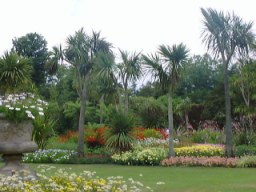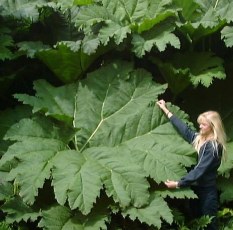
|
Logan Botanic Gardens |

|
By Julie Kilpatrick

Situated in the Rhinns of Galloway, a narrow peninsula that juts out into the Irish Sea, Logan Botanic Garden owes its exotic collection to the warming influence of the Gulf Stream. Palm trees and tender perennials, that would be killed off by frosts in inland areas, thrive here.
The walled garden is where most of the interest lies, at least in terms of colour. An avenue of Cordyline Australis towers over an impressive collection of tender perennials - diascias, osteospermums and salvias to name but a few. This is where you will see an excellent example of how to plant perennials if you have the room. No single planting here, all the varieties are in groups for maximum effect.

Part of the fun of visiting gardens like Logan is when you discover a plant you've never really noticed before. It was surrounding the lily pond that I saw, and immediately fell in love with, Dierama pendulum. A perfect plant for situating near a pond, it grows to five foot high with bell-shaped, pinkish-purple flowers. The designers at Logan have used it to great effect, allowing the stems to reach out over the pond so that the flowers are mirrored in the water. Its common name is 'Angel's fishing rod' and it is certainly well-named. I've probably seen this plant a hundred times at various nurseries but it's not until you see it so well-positioned that you can appreciate it.

At the foot of the lily pond, there is a rather impressive group of tree ferns. Very much a plant of the moment, Dicksonia antartica has enjoyed much popularity with garden designers because it looks so exotic. But don't let people tell you it's an easy plant to keep. Expensive to buy, it's worthwhile knowing that, while it will live quite happily in this country, you do need to give it some care. You should spray the fronds often in summer. In winter, you will have to wrap up the stem in fleece to protect it from frost. So, while tree ferns make a nice feature plant, if your garden is subject to heavy winter frosts, remember that your lovely feature plant will spend a quarter of the year wrapped up in not-so-lovely horticultural fleece!

Behind the tree ferns is the Terrace Garden. Another example of good design, it uses the height differences created by the retaining walls to great effect - tall perennials crammed into the lower terrace, climbers trained against the back wall and another lily pond in the centre, reflecting all the planting around it.
Away from the walled garden, the woodlands are spread out over the rest of Logan's twenty-five acres. Here, you will find one of my favourite trees, Eucalyptus, in abundance. Evergreen, with wonderful silver leaves and a characteristic scent, it also has the added advantage of a beautiful snakeskin bark. At the edge of the South Woodland is the Chusan Palm Avenue. This is Trachycarpus fortunei, very exotic looking with fan-like, divided leaves. Yes, it will grow in mild areas of this country but it suffers badly from strong winds and it lets you know it's suffering too. Even the Chusan palms at Logan were looking rather raggedy.

I left the best to last on my visit to Logan and, with much excitement, went in search of the Gunnera Bog. Why do I like this plant so much? Because I just love big, structural plants with big leaves and they don't come much bigger and more structural than a mature Gunnera manicata. It's hard to believe that these plants all but disappear in winter. Gunnera is relatively easy to grow. It likes plenty of water, so place it in a damp site. If your garden suffers from hard frosts in winter, then cover the crowns to protect them. Plant your Gunnera in damp shade, give it space and then sit back and watch it grow! It really is one of the best.
Logan is definitely worth a visit, especially if you are into exotic or unusual plants but I was disappointed by the size of it. I must admit I expected it to be bigger and I couldn't justify spending a whole day there. So, if you plan to make the trip, visit Tourist Information at one of the towns on the way and find something else to do for the rest of the day!
You might also want to read...

|
The Eden Project
Walking towards Eden from one of its many car parks, I felt a certain sense of anticipation. Was I really going to experience a tropical rainforest, right here in Cornwall?.....Read more |
Home
Contact
Submit a Site
Syndication
Write for Us
Back Copy
RSS Feed
Shopping
Garden Designers
Gardening Sites
Gardens to Visit
Gardener's Homepages
Gardening Courses
© Gardenzine. 2006 - 2009. All rights reserved
© Gardenzine. 2006 - 2009. All rights reserved
| Articles by Category | ||
| Current Features | ||
| Gardening Projects | ||
| Garden Design | ||
| Plants and Maintenance | ||
| Classified | ||
| Shopping | ||
| Garden Designers | ||
| Gardening Sites | ||
| Gardens to Visit | ||
| Gardener's Homepages | ||
| Gardening Courses | ||
| Write for Gardenzine | ||
| Submit a Site | ||
| Syndication | ||
| Contact Gardenzine | ||
| Back Copy | ||
| Free online home garden design course | ||
| ||

|
||
|
| ||
| Related Content | ||
| ON GARDENZINE: | ||
| Discover Britain's mazes | ||
| The Eden Project | ||
| Brisbane Botanics | Eucalyptus | |
| ON THE WEB: | ||
| Logan Botanics Website |

